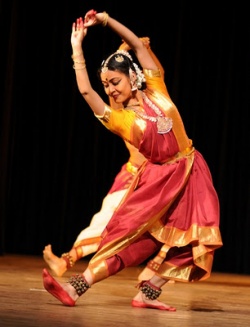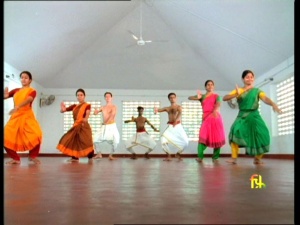Kalākshetra: Difference between revisions
No edit summary |
No edit summary |
||
| (14 intermediate revisions by 2 users not shown) | |||
| Line 1: | Line 1: | ||
[[File:Kalakshetra Bharatanatyam.jpg|250px|right|thumb|Student dancing]] | |||
[[ | '''Kalākshetra''' is a foundation and school supporting dance and allied arts native to India. It was founded in 1936 by [[Rukmini Devi Arundale]]. According to the foundation's website: | ||
[[ | |||
<blockquote> | |||
It provides a holistic education in arts amidst a serene and inspiring natural environment cultivating a spirit of reverence... | |||
Kalakshetra focuses on bharatanatyam, carnatic vocal and instrumental music, the visual arts, traditional crafts and textile design, textual heritage, aesthetics, history and philosophy. ... | |||
Kalakshetra Foundation comprises of Kalakshetra, The Besant Theosophical High School, The Besant Arundale Senior Secondary School, a Craft Education and Research Centre including the Weaving Department, the Kalamkari Natural-Dye Printing & Painting unit, the Visual Arts Center, the Bharata Kalakshetra Auditorium, the Rukmini Arangam, four libraries, the Rukmini Devi Museum, hostels, staff quarters and guest houses. | |||
<ref>"About Kalakshetra" at [http://www.kalakshetra.net/ Kalakshetra Website].</ref> | |||
</blockquote> | |||
[[File:Kalakshetra logo.jpg|180px|right|thumb|Logo of Kalakshetra Foundation]] | |||
== Name == | |||
Originally called the International Center for Arts, the organization was renamed as Kalākshetra, which literally means a holy place of arts (Kala: Arts, Kshetra: Field or Holy place).<ref>[http://www.kalakshetra.net/ Kalakshetra Website].</ref> | |||
== History == | |||
Rukmini | Rukmini Devi Arundale became interested in the classical dance of India after encouragement from ballet star Anna Pavlova. Rukmini studied dance, and refined dance forms that had become degraded. She rechristened the so-called devadasi dance as '''bharatanatyam'''. Her first public performance was at the [[Diamond Jubilee Convention]] of the [[Theosophical Society (Adyar)|Theosophical Society]] in 1935. Her husband, [[George S. Arundale]], was President of the Society. She wrote, "At the Diamond Jubilee Convention we had expected about two hundred people but two thousand turned up. There was so much excitement. More than anything, it totally changed people's prejudice towards the dance."<ref>Rukmini Devi Arundale, "Rukmini on Herself," ''Rukmini Devi Arundale: Birth Centenary Commemorative Volume'', Shakuntala Ramani, ed., (Chennai, India: The Kalakshetra Foundation, 2003), 46.</ref> She continued: "Dr. Arundale himself thought at first it was a delightful hobby but when he saw me dance during that Diamond Jubilee Convention in 1935, he was greatly moved. He told me later it was a spiritual experience like a meditation."<ref>Ibid., 46.</ref> | ||
in January, 1936, the Arundales founded the '''International Center for Arts''', which was later given the Indian name Kalākshetra. Rukmini Devi became President of the new school foundation, with [[James H. Cousins]] as Vice President, and George Arundale and [[Curuppumullage Jinarājadāsa|C. Jinarājadāsa]] as "Patrons". At the inauguration, among those who spoke was Jinarājadāsa who said, "Today we are starting an organisation for the arts. It is surely a logical development of our work. Indeed this is a lovely event today, that in this Theosophical Society we have realised so fully the need of art. I hope the academy (Kalakshetra) will give us the inspiration we all need, so that we will understand better our work and better our ideals of Theosophy." At the Annual Convention of the Theosophical Society in 1940, George Arundale, then President, declared: "Today it is a humble cottage, this Kalakshetra, but in due course we shall have buildings, beautiful, simple structures created by our own hands, the Temple to India's glory. It is a cottage today; it will be a community tomorrow." | |||
The arts center initially occupied space on the [[Adyar (campus)|campus]] of the Theosophical Society, but Rukmini Devi sawth In 1945, Rukmini Devi began buying parcels of land in the village of Thiruvanmiyur. "Land was cheap, around Rs.300 per acre and over the years a great deal came to be acquired, though only in patches, when available. The institution we all see today and have in the last 60 years, stands on part of that patch."<ref>Ashish Mohan Khokar, "Rukmini Devi's Arangetram," the Dance History column in Narthaki Web page [http://www.narthaki.com/info/tdhc/tdhc4.html]</ref> In 1949, Theosophical Society President [[Curuppumullage Jinarājadāsa|C. Jinarājadāsa]] came to feel that Kalakshetra was not quite compatible with the central focus of the Society. He asked Rukmini to move the school off the Adyar campus, which was accomplished by the middle of 1953.<ref>Ashish Mohan Khokar, "Rukmini Devi's Arangetram," the Dance History column in Narthaki Web page [http://www.narthaki.com/info/tdhc/tdhc4.html]</ref> | |||
[[File:Kalakshetra-5.jpg|300px|right|thumb|Students dancing]] | |||
== Famous alumni == | |||
[[Radha Burnier]], Rukmini's niece, was one of the first graduates of the school. | |||
== Awards and recognition == | |||
In January 1994, an Act of the Indian Parliament recognised the Kalakshetra Foundation as an '''Institute of National Importance'''.<ref>[http://www.kalakshetra.in/act.pdf Kalakshetra Foundation Act 1993] Ministry of Law And Justice.</ref><ref>[http://www.chennaibest.com/discoverchennai/personalities/dance1.asp chennaibest.com]</ref> | |||
Rukmini Devi was the recipient of many [[Rukmini Devi Arundale#Awards and honors|honors and awards]]. | |||
== Additional resources == | |||
=== Films and videos === | |||
* '''[http://www.youtube.com/watch?v=PImtabQ4ltA Kalakshetra School of Music and Dance]''' by DreamsTravelTours. 2012. | |||
* '''[http://www.youtube.com/watch?v=fnLfVFvyxCk Bharatanatyam Basic technique Kalakshetra Bani volume-1]''' by Kaladriya. 2011. "This product, the first in the series, attempts to document and perpetuate Smt. Rukmini Devi's legacy in a humble manner." | |||
* '''[http://www.youtube.com/watch?v=mi2_IzNSNjsBharatanatyam Kalakshetra Bani Vol 2 Adavus, Alarippu, Jathiswaram, Shabdam]''' by Kalakriya. 2011. "This product, the second in the series, presents an authentic documentation of the 'Kalakshetra Bani'- a distinctive Bharatanatyam style revived, refined and contemporized by Smt. Rukmini Devi Arundale, the founder of Kalakshetra." | |||
* Packirisamy, V., director. ''Kalakshetra''. Films Division, Ministry of Information and Broadcasting Government of India. 2008. DVD available for sale at [http://filmsdivision.org/shop/kalakshetra Films Divisions website]. "The film looks at the efforts taken by Smt. Rukmini Devi Arundate to set up an institution for reviving Bharata Natyam in the early part of 20th century." | |||
* Tripmonk0. ''Kalakshetra by Louis Malle''. 2008. "The full sequence from Louis Malle's epic series. It does amaze one with his ignorance &, at times, racial comments." | |||
=== Books -=== | |||
* ''Art and Culture in Indian Life''. Trivandrum: Kerala University Press, 1975. | |||
* Arundale, Rukmini Devi. ''Selections, Some Selected Speeches & Writings of Rukmini Devi Arundale''. Chennai: Kalakshetra Foundation, 2003. | |||
* Fredericks, Leo: ''Poet in Kalakshetra''. Madras 1977. | |||
* Kothari, Sunil. ''Photo Biography of Rukmini Devi''. Chennai, The Kalakshetra Foundation, 2004. | |||
* Meduri, Avanthi. ''Rukmini Devi Arundale (1904-1986), A Visionary Architect of Indian Culture and the Performing Arts''. Delhi: Motilal Banarsidass, 2005. ISBN 81-208-2740-6. | |||
* Nachiappan, C. ''Rukmini Devi: Bharata Natya''. Chennai: Kalakshetra Publications, 2003. | |||
* Nachiappan, C. ''Rukmini Devi: Dance Drama''. Chennai: Kalakshetra Publications, 2003. | |||
* Ramani, Shakuntala, ed. ''Rukmini Devi Arundale: Birth Centenary Volume''. Chennai: Kalakshetra Foundation, 2003. | |||
* Samson, Leela. ''Rukmini Devi: A Life''. Delhi: Penguin Books, India, 2010. ISBN 067008264. | |||
* Sarada, S. ''Kalakshetra-Rukmini Devi, Reminiscences''. Madras: Kala Mandir Trust, 1985. | |||
* ''Shraddanjali, Brief Pen Portraits of a Galaxy of Great People Who Laid the Foundations of Kalakshetra''. Chennai: Kalakshetra Foundation, 2004. | |||
=== Articles === | |||
* [https://www.theosophy.world/encyclopedia/kalakshetra-foundation Kalakshetra Foundation] in Theosophy World. | |||
=== Websites === | |||
* [http://www.kalakshetra.net/ Kalakshetra Website]. | |||
== Notes == | |||
<references/> | |||
[[Category:Educational institutions and programs|Kaākshetra]] | |||
Latest revision as of 22:42, 29 February 2024
Kalākshetra is a foundation and school supporting dance and allied arts native to India. It was founded in 1936 by Rukmini Devi Arundale. According to the foundation's website:
It provides a holistic education in arts amidst a serene and inspiring natural environment cultivating a spirit of reverence...
Kalakshetra focuses on bharatanatyam, carnatic vocal and instrumental music, the visual arts, traditional crafts and textile design, textual heritage, aesthetics, history and philosophy. ...
Kalakshetra Foundation comprises of Kalakshetra, The Besant Theosophical High School, The Besant Arundale Senior Secondary School, a Craft Education and Research Centre including the Weaving Department, the Kalamkari Natural-Dye Printing & Painting unit, the Visual Arts Center, the Bharata Kalakshetra Auditorium, the Rukmini Arangam, four libraries, the Rukmini Devi Museum, hostels, staff quarters and guest houses. [1]
Name
Originally called the International Center for Arts, the organization was renamed as Kalākshetra, which literally means a holy place of arts (Kala: Arts, Kshetra: Field or Holy place).[2]
History
Rukmini Devi Arundale became interested in the classical dance of India after encouragement from ballet star Anna Pavlova. Rukmini studied dance, and refined dance forms that had become degraded. She rechristened the so-called devadasi dance as bharatanatyam. Her first public performance was at the Diamond Jubilee Convention of the Theosophical Society in 1935. Her husband, George S. Arundale, was President of the Society. She wrote, "At the Diamond Jubilee Convention we had expected about two hundred people but two thousand turned up. There was so much excitement. More than anything, it totally changed people's prejudice towards the dance."[3] She continued: "Dr. Arundale himself thought at first it was a delightful hobby but when he saw me dance during that Diamond Jubilee Convention in 1935, he was greatly moved. He told me later it was a spiritual experience like a meditation."[4]
in January, 1936, the Arundales founded the International Center for Arts, which was later given the Indian name Kalākshetra. Rukmini Devi became President of the new school foundation, with James H. Cousins as Vice President, and George Arundale and C. Jinarājadāsa as "Patrons". At the inauguration, among those who spoke was Jinarājadāsa who said, "Today we are starting an organisation for the arts. It is surely a logical development of our work. Indeed this is a lovely event today, that in this Theosophical Society we have realised so fully the need of art. I hope the academy (Kalakshetra) will give us the inspiration we all need, so that we will understand better our work and better our ideals of Theosophy." At the Annual Convention of the Theosophical Society in 1940, George Arundale, then President, declared: "Today it is a humble cottage, this Kalakshetra, but in due course we shall have buildings, beautiful, simple structures created by our own hands, the Temple to India's glory. It is a cottage today; it will be a community tomorrow."
The arts center initially occupied space on the campus of the Theosophical Society, but Rukmini Devi sawth In 1945, Rukmini Devi began buying parcels of land in the village of Thiruvanmiyur. "Land was cheap, around Rs.300 per acre and over the years a great deal came to be acquired, though only in patches, when available. The institution we all see today and have in the last 60 years, stands on part of that patch."[5] In 1949, Theosophical Society President C. Jinarājadāsa came to feel that Kalakshetra was not quite compatible with the central focus of the Society. He asked Rukmini to move the school off the Adyar campus, which was accomplished by the middle of 1953.[6]
Famous alumni
Radha Burnier, Rukmini's niece, was one of the first graduates of the school.
Awards and recognition
In January 1994, an Act of the Indian Parliament recognised the Kalakshetra Foundation as an Institute of National Importance.[7][8]
Rukmini Devi was the recipient of many honors and awards.
Additional resources
Films and videos
- Kalakshetra School of Music and Dance by DreamsTravelTours. 2012.
- Bharatanatyam Basic technique Kalakshetra Bani volume-1 by Kaladriya. 2011. "This product, the first in the series, attempts to document and perpetuate Smt. Rukmini Devi's legacy in a humble manner."
- Kalakshetra Bani Vol 2 Adavus, Alarippu, Jathiswaram, Shabdam by Kalakriya. 2011. "This product, the second in the series, presents an authentic documentation of the 'Kalakshetra Bani'- a distinctive Bharatanatyam style revived, refined and contemporized by Smt. Rukmini Devi Arundale, the founder of Kalakshetra."
- Packirisamy, V., director. Kalakshetra. Films Division, Ministry of Information and Broadcasting Government of India. 2008. DVD available for sale at Films Divisions website. "The film looks at the efforts taken by Smt. Rukmini Devi Arundate to set up an institution for reviving Bharata Natyam in the early part of 20th century."
- Tripmonk0. Kalakshetra by Louis Malle. 2008. "The full sequence from Louis Malle's epic series. It does amaze one with his ignorance &, at times, racial comments."
Books -
- Art and Culture in Indian Life. Trivandrum: Kerala University Press, 1975.
- Arundale, Rukmini Devi. Selections, Some Selected Speeches & Writings of Rukmini Devi Arundale. Chennai: Kalakshetra Foundation, 2003.
- Fredericks, Leo: Poet in Kalakshetra. Madras 1977.
- Kothari, Sunil. Photo Biography of Rukmini Devi. Chennai, The Kalakshetra Foundation, 2004.
- Meduri, Avanthi. Rukmini Devi Arundale (1904-1986), A Visionary Architect of Indian Culture and the Performing Arts. Delhi: Motilal Banarsidass, 2005. ISBN 81-208-2740-6.
- Nachiappan, C. Rukmini Devi: Bharata Natya. Chennai: Kalakshetra Publications, 2003.
- Nachiappan, C. Rukmini Devi: Dance Drama. Chennai: Kalakshetra Publications, 2003.
- Ramani, Shakuntala, ed. Rukmini Devi Arundale: Birth Centenary Volume. Chennai: Kalakshetra Foundation, 2003.
- Samson, Leela. Rukmini Devi: A Life. Delhi: Penguin Books, India, 2010. ISBN 067008264.
- Sarada, S. Kalakshetra-Rukmini Devi, Reminiscences. Madras: Kala Mandir Trust, 1985.
- Shraddanjali, Brief Pen Portraits of a Galaxy of Great People Who Laid the Foundations of Kalakshetra. Chennai: Kalakshetra Foundation, 2004.
Articles
- Kalakshetra Foundation in Theosophy World.
Websites
Notes
- ↑ "About Kalakshetra" at Kalakshetra Website.
- ↑ Kalakshetra Website.
- ↑ Rukmini Devi Arundale, "Rukmini on Herself," Rukmini Devi Arundale: Birth Centenary Commemorative Volume, Shakuntala Ramani, ed., (Chennai, India: The Kalakshetra Foundation, 2003), 46.
- ↑ Ibid., 46.
- ↑ Ashish Mohan Khokar, "Rukmini Devi's Arangetram," the Dance History column in Narthaki Web page [1]
- ↑ Ashish Mohan Khokar, "Rukmini Devi's Arangetram," the Dance History column in Narthaki Web page [2]
- ↑ Kalakshetra Foundation Act 1993 Ministry of Law And Justice.
- ↑ chennaibest.com


